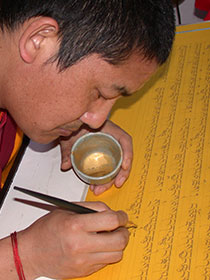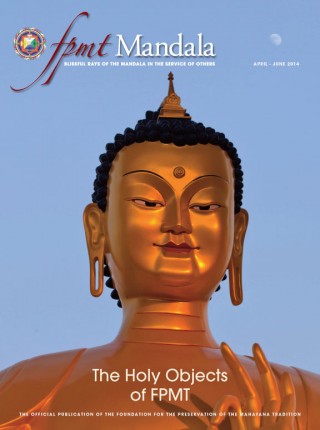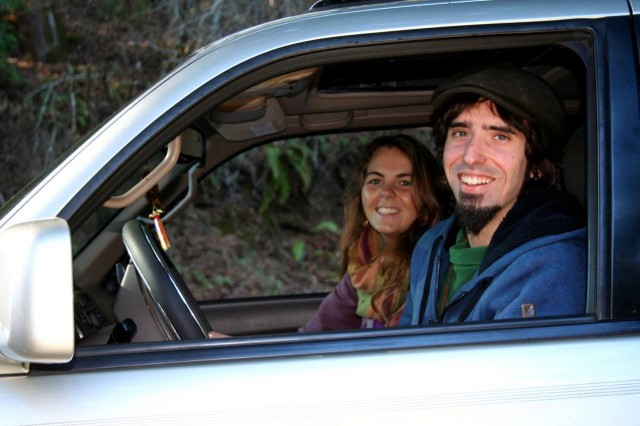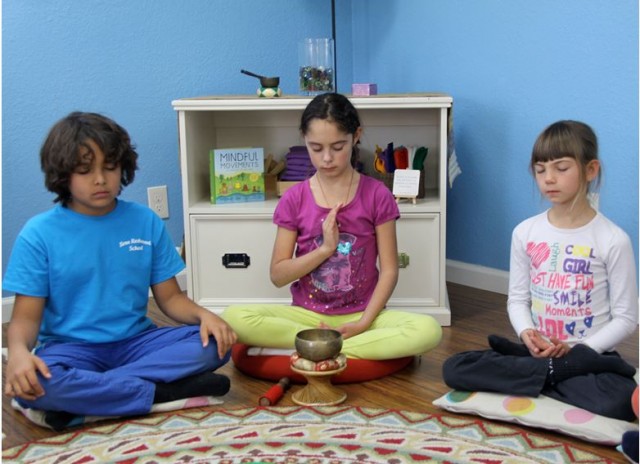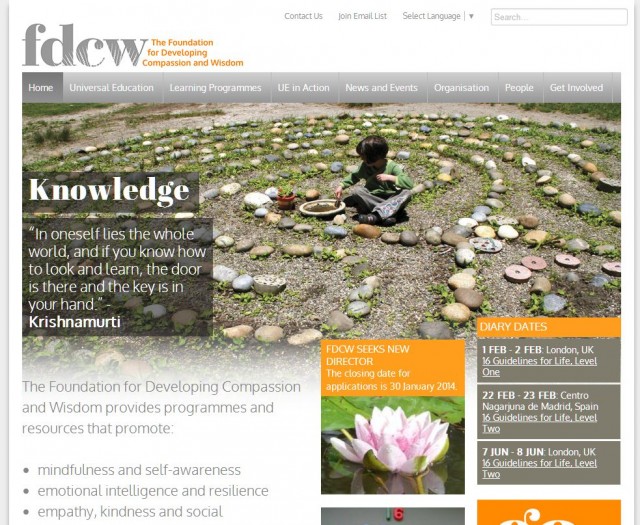- Home
- FPMT Homepage
Foundation for the Preservation of the Mahayana Tradition
The FPMT is an organization devoted to preserving and spreading Mahayana Buddhism worldwide by creating opportunities to listen, reflect, meditate, practice and actualize the unmistaken teachings of the Buddha and based on that experience spreading the Dharma to sentient beings. We provide integrated education through which people’s minds and hearts can be transformed into their highest potential for the benefit of others, inspired by an attitude of universal responsibility and service. We are committed to creating harmonious environments and helping all beings develop their full potential of infinite wisdom and compassion. Our organization is based on the Buddhist tradition of Lama Tsongkhapa of Tibet as taught to us by our founders Lama Thubten Yeshe and Lama Thubten Zopa Rinpoche.
- Willkommen
Die Stiftung zur Erhaltung der Mahayana Tradition (FPMT) ist eine Organisation, die sich weltweit für die Erhaltung und Verbreitung des Mahayana-Buddhismus einsetzt, indem sie Möglichkeiten schafft, den makellosen Lehren des Buddha zuzuhören, über sie zur reflektieren und zu meditieren und auf der Grundlage dieser Erfahrung das Dharma unter den Lebewesen zu verbreiten.
Wir bieten integrierte Schulungswege an, durch denen der Geist und das Herz der Menschen in ihr höchstes Potential verwandelt werden zum Wohl der anderen – inspiriert durch eine Haltung der universellen Verantwortung und dem Wunsch zu dienen. Wir haben uns verpflichtet, harmonische Umgebungen zu schaffen und allen Wesen zu helfen, ihr volles Potenzial unendlicher Weisheit und grenzenlosen Mitgefühls zu verwirklichen.
Unsere Organisation basiert auf der buddhistischen Tradition von Lama Tsongkhapa von Tibet, so wie sie uns von unseren Gründern Lama Thubten Yeshe und Lama Thubten Zopa Rinpoche gelehrt wird.
- Bienvenidos
La Fundación para la preservación de la tradición Mahayana (FPMT) es una organización que se dedica a preservar y difundir el budismo Mahayana en todo el mundo, creando oportunidades para escuchar, reflexionar, meditar, practicar y actualizar las enseñanzas inconfundibles de Buda y en base a esa experiencia difundir el Dharma a los seres.
Proporcionamos una educación integrada a través de la cual las mentes y los corazones de las personas se pueden transformar en su mayor potencial para el beneficio de los demás, inspirados por una actitud de responsabilidad y servicio universales. Estamos comprometidos a crear ambientes armoniosos y ayudar a todos los seres a desarrollar todo su potencial de infinita sabiduría y compasión.
Nuestra organización se basa en la tradición budista de Lama Tsongkhapa del Tíbet como nos lo enseñaron nuestros fundadores Lama Thubten Yeshe y Lama Zopa Rinpoche.
A continuación puede ver una lista de los centros y sus páginas web en su lengua preferida.
- Bienvenue
L’organisation de la FPMT a pour vocation la préservation et la diffusion du bouddhisme du mahayana dans le monde entier. Elle offre l’opportunité d’écouter, de réfléchir, de méditer, de pratiquer et de réaliser les enseignements excellents du Bouddha, pour ensuite transmettre le Dharma à tous les êtres. Nous proposons une formation intégrée grâce à laquelle le cœur et l’esprit de chacun peuvent accomplir leur potentiel le plus élevé pour le bien d’autrui, inspirés par le sens du service et une responsabilité universelle. Nous nous engageons à créer un environnement harmonieux et à aider tous les êtres à épanouir leur potentiel illimité de compassion et de sagesse. Notre organisation s’appuie sur la tradition guéloukpa de Lama Tsongkhapa du Tibet, telle qu’elle a été enseignée par nos fondateurs Lama Thoubtèn Yéshé et Lama Zopa Rinpoché.
Visitez le site de notre Editions Mahayana pour les traductions, conseils et nouvelles du Bureau international en français.
Voici une liste de centres et de leurs sites dans votre langue préférée
- Benvenuto
L’FPMT è un organizzazione il cui scopo è preservare e diffondere il Buddhismo Mahayana nel mondo, creando occasioni di ascolto, riflessione, meditazione e pratica dei perfetti insegnamenti del Buddha, al fine di attualizzare e diffondere il Dharma fra tutti gli esseri senzienti.
Offriamo un’educazione integrata, che può trasformare la mente e i cuori delle persone nel loro massimo potenziale, per il beneficio di tutti gli esseri, ispirati da un’attitudine di responsabilità universale e di servizio.
Il nostro obiettivo è quello di creare contesti armoniosi e aiutare tutti gli esseri a sviluppare in modo completo le proprie potenzialità di infinita saggezza e compassione.
La nostra organizzazione si basa sulla tradizione buddhista di Lama Tsongkhapa del Tibet, così come ci è stata insegnata dai nostri fondatori Lama Thubten Yeshe e Lama Zopa Rinpoche.
Di seguito potete trovare un elenco dei centri e dei loro siti nella lingua da voi prescelta.
- 欢迎 / 歡迎
简体中文
“护持大乘法脉基金会”( 英文简称:FPMT。全名:Foundation for the Preservation of the Mahayana Tradition) 是一个致力于护持和弘扬大乘佛法的国际佛教组织。我们提供听闻,思维,禅修,修行和实证佛陀无误教法的机会,以便让一切众生都能够享受佛法的指引和滋润。
我们全力创造和谐融洽的环境, 为人们提供解行并重的完整佛法教育,以便启发内在的环宇悲心及责任心,并开发内心所蕴藏的巨大潜能 — 无限的智慧与悲心 — 以便利益和服务一切有情。
FPMT的创办人是图腾耶喜喇嘛和喇嘛梭巴仁波切。我们所修习的是由两位上师所教导的,西藏喀巴大师的佛法传承。
繁體中文
護持大乘法脈基金會”( 英文簡稱:FPMT。全名:Found
ation for the Preservation of the Mahayana Tradition ) 是一個致力於護持和弘揚大乘佛法的國際佛教組織。我們提供聽聞, 思維,禪修,修行和實證佛陀無誤教法的機會,以便讓一切眾生都能 夠享受佛法的指引和滋潤。 我們全力創造和諧融洽的環境,
為人們提供解行並重的完整佛法教育,以便啟發內在的環宇悲心及責 任心,並開發內心所蘊藏的巨大潛能 — 無限的智慧與悲心 – – 以便利益和服務一切有情。 FPMT的創辦人是圖騰耶喜喇嘛和喇嘛梭巴仁波切。
我們所修習的是由兩位上師所教導的,西藏喀巴大師的佛法傳承。 察看道场信息:
- FPMT Homepage
- News/Media
-
- Study & Practice
-
-
- About FPMT Education Services
- Latest News
- Programs
- New to Buddhism?
- Buddhist Mind Science: Activating Your Potential
- Heart Advice for Death and Dying
- Discovering Buddhism
- Living in the Path
- Exploring Buddhism
- FPMT Basic Program
- FPMT Masters Program
- FPMT In-Depth Meditation Training
- Maitripa College
- Lotsawa Rinchen Zangpo Translator Program
- Universal Education for Compassion & Wisdom
- Online Learning Center
-
- Prayers & Practice Materials
- Overview of Prayers & Practices
- Full Catalogue of Prayers & Practice Materials
- Explore Popular Topics
- Benefiting Animals
- Chenrezig Resources
- Death & Dying Resources
- Lama Chopa (Guru Puja)
- Lama Zopa Rinpoche: Compendium of Precious Instructions
- Lama Zopa Rinpoche: Life Practice Advice
- Lama Zopa Rinpoche Practice Series
- Lamrim Resources
- Mantras
- Prayer Book Updates
- Purification Practices
- Sutras
- Thought Transformation (Lojong)
- Audio Materials
- Dharma Dates - Tibetan Calendar
- Translation Services
- Publishing Services
- Ways to Offer Support
- Prayers & Practice Materials
-
- Teachings and Advice
- Find Teachings and Advice
- Lama Zopa Rinpoche Advice Page
- Lama Zopa Rinpoche: Compendium of Precious Instructions
- Lama Zopa Rinpoche Video Teachings
- ༧སྐྱབས་རྗེ་བཟོད་པ་རིན་པོ་ཆེ་མཆོག་ནས་སྩལ་བའི་བཀའ་སློབ་བརྙན་འཕྲིན།
- Podcasts
- Lama Yeshe Wisdom Archive
- Buddhism FAQ
- Dharma for Young People
- Resources on Holy Objects
- Teachings and Advice
-
-
*If a menu item has a submenu clicking once will expand the menu clicking twice will open the page.
-
-
- Centers
-
- Teachers
-
- Projects
-
-
-
-
*If a menu item has a submenu clicking once will expand the menu clicking twice will open the page.
-
-
- FPMT
-
-
-
-
-
You are responsible for your own problems just as you’re responsible for your own liberation and enlightenment.
Lama Zopa Rinpoche
-
-
-
- Shop
-
-
-
The Foundation Store is FPMT’s online shop and features a vast selection of Buddhist study and practice materials written or recommended by our lineage gurus. These items include homestudy programs, prayers and practices in PDF or eBook format, materials for children, and other resources to support practitioners.
Items displayed in the shop are made available for Dharma practice and educational purposes, and never for the purpose of profiting from their sale. Please read FPMT Foundation Store Policy Regarding Dharma Items for more information.
-
-
FPMT Community: Stories & News
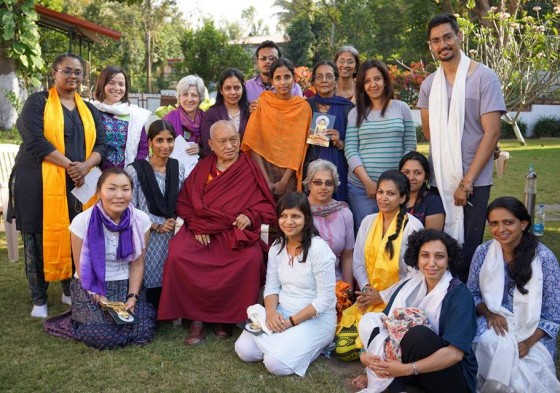
Lama Zopa Rinpoche with Choe Khor Sum Ling students at the Jangchup Lamrim teachings, Sera Je Monastery, India, December 2013. Photo by Bill Kane.
Dee Shekhar, member of Choe Khor Sum Ling in Bangalore, India, shares news from the December 2013 Jangchup Lamrim teachings with His Holiness the Dalai Lama at Sera Je Monastery in South India:
The month of December proved to be doubly important for the members of Choe Khor Sum Ling. We were very blessed to receive Kyabje Lama Zopa Rinpoche in Bangalore and two members of our center had the unique blessing of hosting Rinpoche and his team for dinner.
On December 24, 2013, the streets of Bylakuppe were thronged with people with khatas for nearly 10 kilometers [6 miles] to welcome His Holiness the Dalai Lama, who began the second installation of incredible Jangchup Lamrim teachings on December 25, 2013. Nearly 30,000 people from different countries waited to see and hear His Holiness teach. The monasteries were kind enough to accommodate people traveling from far and wide.
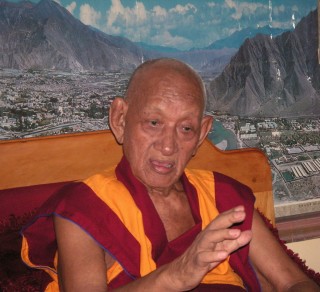
Khensur Lobsang Tsering, the inaugural speaker at Choe Khor Sum Ling’s founding, was also at the Jangchup Lamrim teachings, Sera Je Monastery, India, December 2013. Photo by Shanti Y.
His Holiness began the teaching at Sera Je Monastery by making his students see the presence of spiritual thought in the world and thanking India for its contribution to Buddhism and also by grounding us in the reality of the 21st century. His Holiness gave the lung and commentary on The Swift Path, The Easy Path, The Essence of Refined Gold, The Essence of Nectar, and The Sacred Words of Manjushri. His Holiness then taught extensively on the greatness of the teachings, the qualities of a teacher, the topic of meditation, bodhichitta – aspiring and engaging, suffering and the hell realms.
His Holiness encouraged students to study Je Tsongkhapa’s In Praise of Dependent Origination on the day of his long life puja. Lama Zopa Rinpoche gave a lung of the text at the Tsawa Khangsten.
On the last day of the teaching, His Holiness bestowed the Avalokiteshvara initiation in connection to aspiring bodhichitta on all his assembled students. The teachings ended with the promise of meeting later this year to study Kyabje Pabongka Rinpoche’s Liberation in the Palm of Your Hand.
Choe Khor Sum Ling members also had the great fortune of making khata offerings to various buddhas and great teachers such as Kyabje Lama Zopa Rinpoche, Khadro-la, Khangser Rinpoche, Ribur Rinpoche, Dagri Rinpoche, Kyongla Rato Rinpoche and His Eminence Kyabje Choden Rinpoche, Khensur Lobsang Tsering and of course His Eminence the 7th Ling Rinpoche, who organized the teachings.
It was a blessing to be amidst all the great teachers and scholarly monks and nuns. All in all, this was a great blessing of pilgrimage for Choe Khor Sum Ling students.
Mandala brings you news of Lama Zopa Rinpoche and of activities, teachings and events from over 160 FPMT centers, projects and services around the globe. If you like what you read on Mandala, consider becoming a Friend of FPMT, which supports our work.
- Tagged: choe khor sum ling, jangchup lamrim, mandala
- 0
5
The New Issue of Mandala Published!
We have just published our new issue of Mandala, featuring coverage of FPMT’s holy objects, including updates on the Maitreya Projects and the Great Stupa of Universal Compassion and celebrating the 40th anniversary of the International Mahayana Institute!
In this issue’s online edition, we share two pages from the print issue featuring news from the Maitreya Buddha Kushinagar Project. You can also find many more stories on FPMT holy objects as well as photos and video from the international FPMT mandala.
The print issue is on its way to readers. If you would like to receive Mandala in your mail box, sign up to Friends of FPMT at the Foundation Friends level and support the all the communication work of FPMT International Office, including the “Lama Zopa Rinpoche News” blog and all of Mandala’s online content.
3
Message from Tenzin Ösel Hita
Occasionally Ösel shares his thoughts and experiences on his Facebook page. In this update, he gives discusses the role every action has on our experience of life.
Life has so many ways of appearing to us. There is such complexity in each moment, each sensation we receive and create. Are we even aware of each passing second, and each experience, which combined, makes what life is for each of us? We may be very subtly aware, but I don’t think we really assimilate how important every action we do is; how habits are so powerful in our daily life. How these “actions” multiply incredibly every time we repeat an action and create the habit. Habits are so strong in our lives. That is why we must be very aware of our habits, and if we feel we are not on the right path towards understanding our inner being, towards nourishing our body and minds, towards helping ourselves and others become more functional, emotionally balanced, peaceful, loving, kind, and joyful; then we must check our habits and focus on what we want to accomplish in the big picture and the long run.
My thoughts are similar to yours. I can identify with emotions humans may have felt in some great moments of their life. I can imagine what it must have been like for the explorers who were discovering something new for themselves and the rest of humanity. Just like an astronaut, who is moving into a new place, a new dimension. What is different from everything else? We are so complex, and each of our organs means so much to our lifestyle. Each breath we take means so much for the next couple minutes we live. Each bite of food we eat, every time we speak, every time we walk, every time we blink. All those moments are so small in our daily life, but yet so big and important. And these are all actions we do consciously. I guess life is so dependent on so many tiny details, that we don’t realize how interdependent on everything else we are every second of our parallel lives.
Thank you everyone for your love and kindness, really appreciate it! Just turned 29 a couple weeks ago.
La vida tiene muchas maneras de aparecerse a nosotros. Hay tal complejidad en cada momento, cada sensación que recibimos y creamos. ¿Somos conscientes de cada segundo que pasa, y cada experiencia que tenemos? Combinados crean lo que es parte de la vida para cada uno de nosotros. Podemos estar conscientes muy sutilmente, pero no creo que realmente asimilemos la importancia detrás de cada acción que tomamos. Por ejemplo; los hábitos son tan poderosos en nuestra vida diaria. Estas “acciones” se multiplican increíblemente cada vez que se repite la acción y esto en cambio crea el hábito. Los hábitos son tan fuertes en nuestras vidas. Es por eso que tenemos que ser muy conscientes de nuestros hábitos; y si sentimos que no estamos en el camino correcto hacia la comprensión de nuestro ser interior, de nutrir nuestro cuerpo y mente, de ayudarnos a nosotros mismos y los demás a ser más funcionales, emocionalmente equilibrados, con paz interior, amorosos, compasivos, y alegres; entonces debemos investigar nuestros hábitos y enfocar lo que queremos cumplir en esta vida, mirando desde fuera de la burbuja, y a lo largo del tiempo.
Mis pensamientos son similares a los tuyos, al igual que yo puedo identificarme con las emociones humanas que podrían haber sentido muchos individuos en algunos grandes momentos de su vida. Me puedo imaginar lo que debe haber sido para los exploradores que estaban descubriendo algo nuevo para ellos y para el resto de la humanidad. Al igual que un astronauta, que está entrando en un nuevo lugar, una nueva dimensión.
Que es diferente de todo lo demás? Somos tan complejos, y cada uno de nuestros órganos es esencial en muchos aspectos para nuestro estilo de vida. Cada aliento de aire que tomamos significa todo para los próximos par de minutos en que el vivimos. Cada bocado de comida que comemos, cada vez que hablamos, cada vez que caminamos, cada vez que parpadeamos. Todos estos momentos son tan pequeños en nuestra vida diaria, pero al mismo tiempo tan grandes e importantes. Y estas solo son acciones que hacemos conscientemente. Supongo que la vida es tan dependiente de tantos pequeños detalles, no nos damos cuenta de lo importante que son las sutilezas de la vida. Todos somos completamente interdependientes del resto de todo lo demás cada segundo de nuestras vidas paralelas.
¡Muchísimas gracias a todo el mundo por tu amor y cariño, lo agradezco un montón! Cumplí 29 años hace unas semanas.
- Tagged: big love fund, tenzin osel hita
28
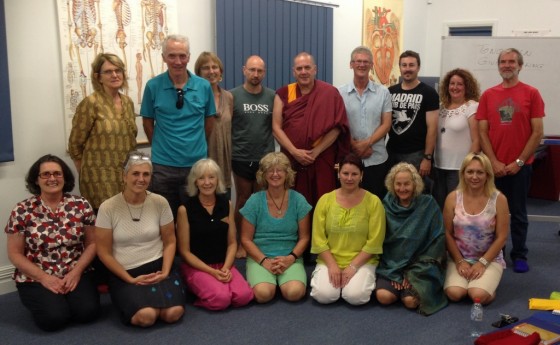
Ven. Lhundrup and the students of Shen Phen Ling Study Group, Victoria, Australia, February 2014. Photo courtesy of Shen Phen Ling.
Julie Klose, study group coordinator for Shen Phen Ling Study Group in northeast Victoria, Australia, offers this message of thanks to Australian monk Ven. Thubten Lhundrup from Thubten Shedrup Ling Monastery:
Shen Phen Ling Study Group in Albury/Wodonga has been blessed to have been receiving monthly teachings on Discovering Buddhism topics from Ven. Lhundrup for several years. His willingness to undertake the four-hour drive from Thubten Shedrup Ling Monastery in Bendigo to Wodonga, and an overnight stay each month, is amazing.
His dedication to sharing the Dharma with us has ensured the continued existence of our group and been of enormous benefit to us all. Although very sad to see him leave us for the time being, we wish him well for his studies in Dharamsala, India.
Mandala brings you news of Lama Zopa Rinpoche and of activities, teachings and events from over 160 FPMT centers, projects and services around the globe. If you like what you read on Mandala, consider becoming a Friend of FPMT, which supports our work.
- Tagged: mandala, shen phen ling study group
- 0

Dusum Sangay Guru Rinpoche statue, February 2014. Photo courtesy of Chandrakirti Tibetan Buddhist Meditation Centre.
Phillipa Rutherford, co-director of New Zealand’s Chandrakirti Tibetan Buddhist Meditation Centre, shares news about the successful completion of some of Lama Zopa Rinpoche’s advice:
We would like to let people know we have manifested a 2-meter (7-foot) Guru Rinpoche (Padmasambhava) statue and we are currently filling it and reorganizing the altar to fit it. This is Dusum Sangay Guru Rinpoche, the manifestation of Guru Rinpoche who dispels all obstacles and brings amazing success.
The statue was crafted in Nepal and Ani Fran at Kopan Monastery coordinated the production of it. We are very happy to have fulfilled this wish of our precious Kyabje Lama Zopa Rinpoche.
Mandala brings you news of Lama Zopa Rinpoche and of activities, teachings and events from over 160 FPMT centers, projects and services around the globe. If you like what you read on Mandala, consider becoming a Friend of FPMT, which supports our work.
- Tagged: chandrakirti centre, mandala, padmasambhava
- 0
14
Creating Compassionate Cultures Launches Online Institute
Creating Compassionate Cultures (CCC), an organization dedicated to providing tools and training to help educators offer children a deeper, holistic education, has recently soft-launched the Online Institute for Creating Compassionate Cultures (OICCC). The Online Institute will offer a 12-course online training program starting March 31, 2014, to educators and anyone interested in learning the CCC methodology – the Seven Steps to Knowledge, Strength and Compassion.
“This comprehensive program engages the inner world of trainees,” explains CCC founder Pam Cayton, “and provides practical tools for implementing the CCC curriculum in a variety of settings. Participants throughout the world can come together in this new online venue and explore course material through original CCC content, contemplative practice, discussion forums and multimedia from some of the leading neuroscientists, educators and psychologists today.”
Inspired by Lama Yeshe’s vision for secular education, the idea for CCC began developing in 1989 at Tara Redwood School in California. Pam officially founded CCC in 2008. “I wanted to give educators a way to offer children a holistic education that addressed not only their academic needs, but their psychological, emotional and social needs, too. For example, the curriculum includes a component for children to learn how to identify emotions by associating them with colors and learning how to express them publicly in appropriate ways. The heart of all of this is the Seven Steps to Knowledge, Strength and Compassion, the theoretical basis that helps the curriculum develop a child’s natural ethics, wisdom and compassion.”
Pam hopes that the OICCC will give interested people more training with the material than could be done in a weekend workshop and expand the “classroom” to a global scale, meaning international students can work together to understand and experiment with the ideas discussed.
“I want people to understand that this program is suitable for parents, teachers, psychologists and anyone who works with children and families,” Pam says. “I believe lots of people can benefit from this and I’m so glad to be carrying on Lama Yeshe’s vision for education in this way.”
Creating Compassionate Cultures invites everyone to preview course offerings on the new OICCC.
- Tagged: children, creating compassionate cultures, mandala, pam cayton
- 0
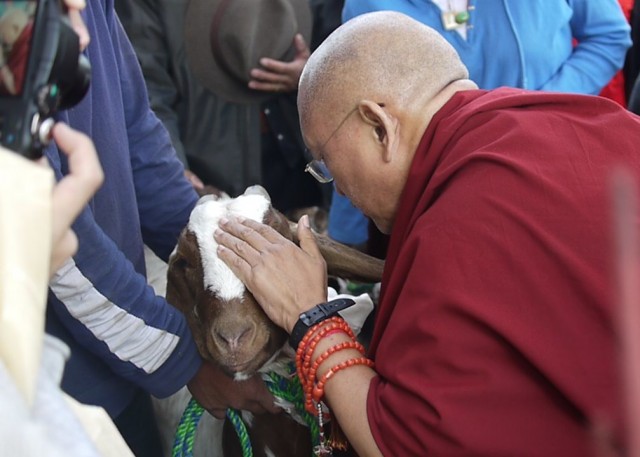
Lama Zopa Rinpoche blessing goat that he liberated, November 2010. Photos courtesy of Tania Duratovic and Phil Hunt.
Animal liberation is a practice often recommend to students for removing obstacles and to create the causes for a long life. With animal liberation, special care needs to be taken since the practice involves direct contact with living beings. Mandala has asked experienced animal liberation practitioners Tania Duratovic and Phil Hunt, coordinators of the Animal Liberation Sanctuary at Kopan Monastery, to share some of their practical knowledge of animal blessing and liberation practices for the January-March 2014 issue of Mandala.
Just what is the difference between animal liberation and an animal blessing? In the Buddhist sense, animal liberation is rescuing animals from impending death and then giving them Dharma by undertaking certain Buddhist practices including circumambulation and mantra recitation. It is usually done as a practice for long life and removing life obstacles, the merits being dedicated to someone else with specific obstacles, as well as to all living beings. An animal blessing, on the other hand, will include the same practices of circumambulation and mantra recitation but the animal involved has not necessarily been recently rescued from death, like someone’s pet.
Whichever activity you are undertaking, liberation or blessing, such Buddhist practices to help animals have many benefits. They help the animals, the people doing the practices and those for whom the practices are dedicated. However, there are also risks and with that comes responsibilities.
Of utmost importance is the care of those living beings by practitioners whether temporarily, prior to release into the wild, or long term as pets or at a sanctuary. While Buddhists believe the karmic benefit of doing these practices will be ongoing and perhaps have a greater effect in future lives, the welfare of the animals in this life is also critical. Animals should be handled and cared for as the “kind mother sentient beings” we are taught that they are, and as the fragile living creatures that share our planet and suffer physically, mentally and emotionally. …
From Mandala January-March 2014
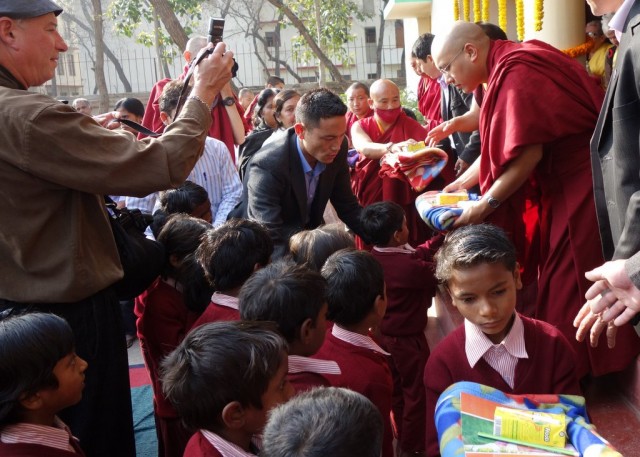
His Holiness the Karmapa offers gifts to Maitreya School children, Bodhgaya, India, January 31, 2014. Photo by Ven. Roger Kunsang.
His Holiness the Karmapa visited Maitreya School and Root Institute in Bodhgaya, India, on January 31. Lama Zopa Rinpoche was also at Root Institute and welcomed His Holiness.
The Maitreya School is a project of Root Institute and offers children a well rounded education that includes instruction in compassion, honesty and loving-kindness as emphasized by the 16 Guidelines, a Universal Education for Compassion and Wisdom program.
While visiting the school, His Holiness the Karmapa gave a talk to more than 100 Maitreya School students and teachers and offered the children gifts. His Holiness also gave a talk at Root Institute.
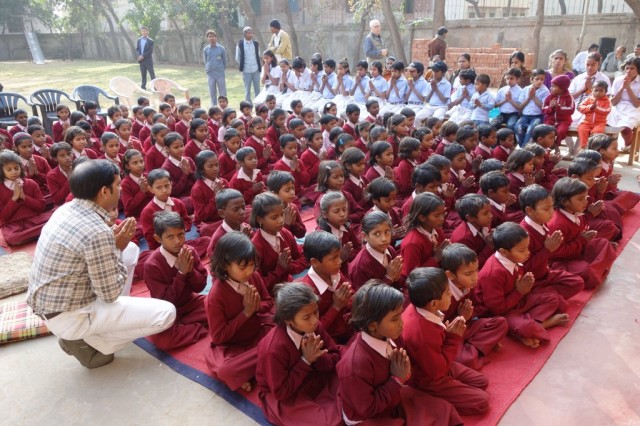
Maitreya School children waiting for a talk by His Holiness the Karmapa, Bodhgaya, January 31, 2014. Photo by Ven. Roger Kunsang.
Mandala brings you news of Lama Zopa Rinpoche and of activities, teachings and events from over 160 FPMT centers, projects and services around the globe. If you like what you read on Mandala, consider becoming a Friend of FPMT, which supports our work.
21
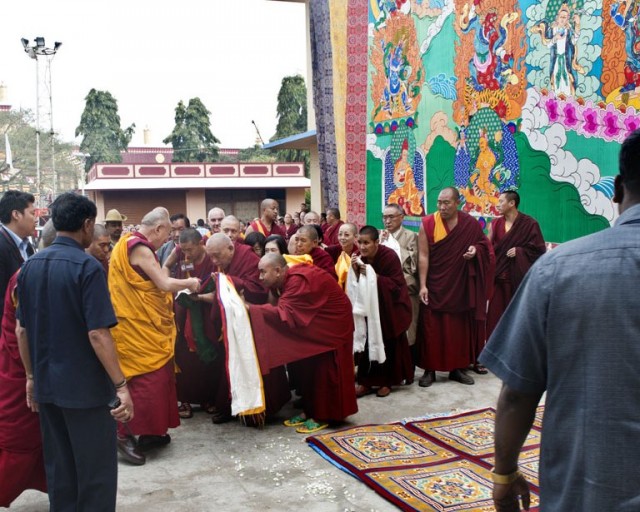
His Holiness the Dalai Lama with Lama Zopa Rinpoche and the giant Guru Rinpoche thangka, Sera Je Monastery, India, December 29, 2013. Photo copyright Rio Helmi/Jangchup Lamrim Teaching Organizing Committee.
The Lama Zopa Rinpoche Bodhichitta Fund, under the instruction of Lama Zopa Rinpoche, sponsored an enormous Guru Rinpoche (Padmasambhava) thangka stitched in appliqué. During the recent Jangchub Lamrim teachings at Sera Monastery, His Holiness the Dalai Lama blessed the thangka early one morning before the teachings.
Rinpoche advised on the design of the thangka, which with its brocade board measures 90-feet (27-meters) wide by 70-feet (23-meters) high. The thangka took two years to make and was completed in 2013. It is for the Guru Rinpoche Bum Tsog (100,000 tsog offerings) in Nepal.
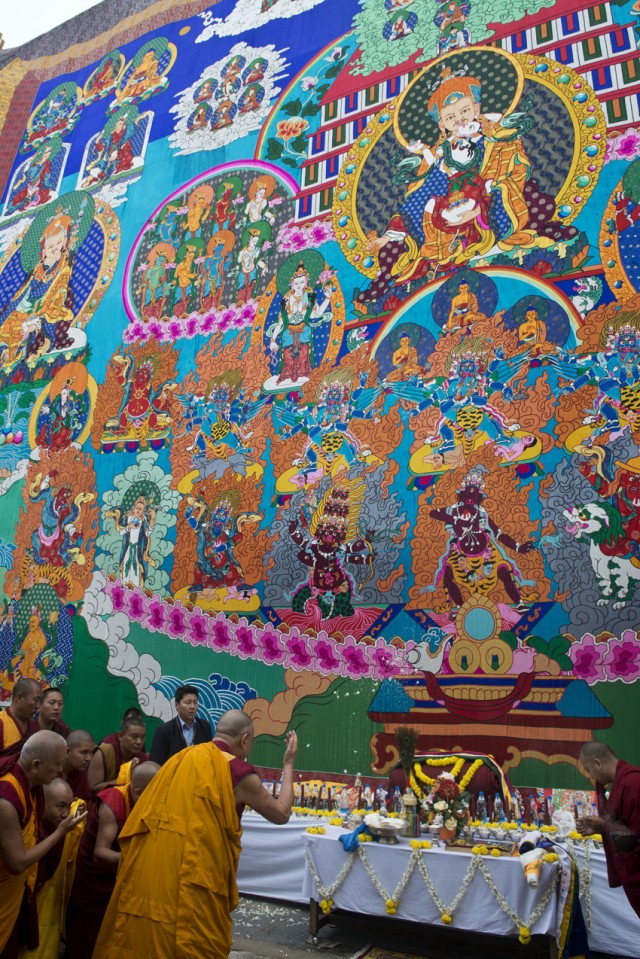
His Holiness the Dalai Lama blessing the thangka, Sera Monastery, India, December 29, 2013. Photo copyright Rio Helmi/Jangchup Lamrim Teaching Organizing Committee.
Mandala brings you news of Lama Zopa Rinpoche and of activities, teachings and events from over 160 FPMT centers, projects and services around the globe. If you like what you read on Mandala, consider becoming a Friend of FPMT, which supports our work.
- Tagged: his holiness the dalai lama, jangchup lamrim, lama zopa rinpoche, lama zopa rinpoche bodhichitta fund, mandala, padmasambhava, thangkas
- 0
17
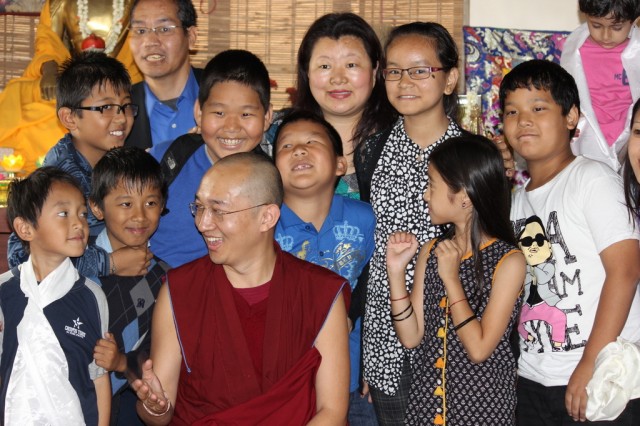
The 8th Khangser Rinpoche helped Choe Khor Sum Ling celebrate its 10th anniversary, Bangalore, India, November 2013. Photo courtesy of Choe Khor Sum Ling.
Choe Khor Sum Ling (CKSL) in Bangalore, India, celebrated its tenth anniversary on November 17, 2013. To celebrate, CKSL organized a special teaching event about transforming everyday experiences into sources of great joy. The teachings also addressed eliminating stress and obstacles; generating boundless joy by cultivating pure love towards others; focusing less on self; focusing more on benefiting others; and reducing expectations and abandoning the thoughts of results.
CKSL is an active study group offering regular instruction in meditation and Buddhist philosophy, including FPMT’s Discovering Buddhism program. International Mahayana Institute monks studying at Sera Monastery regularly give teachings to CKSL students, who are “a lively group of kind, open-minded Indians, Tibetans and foreigners, both young and old.”
Mandala brings you news of Lama Zopa Rinpoche and of activities, teachings and events from over 160 FPMT centers, projects and services around the globe. If you like what you read on Mandala, consider becoming a Friend of FPMT, which supports our work.
- Tagged: choe khor sum ling, khangser rinpoche, mandala
- 0
14
Guhyasamaja Center Student Ordains
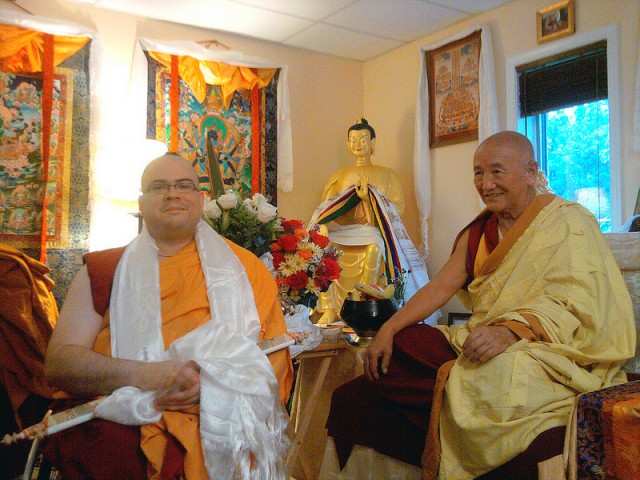
Gyumed Khensur Rinpoche Lobsang Jampa ordained Guhyasamaja Center student Matt Gausman, now Ven. Losang Dondrub, Fairfax, Virginia, US, October 2013. Photos courtesy of Guhyasamaja Center.
From Fairfax, Virginia, US, Guhyasamaja Center spiritual program coordinator Gabriel Mata shares the exciting news of one student’s transition into monkhood:
On October 11, 2013, Guhyasamaja Center celebrated the ordination ceremony of one of its members and membership coordinator, Matt Gausman. The ceremony was conducted by the center’s resident teacher Gyumed Khensur Rinpoche Lobsang Jampa assisted by some of his own students, Geshe Dargye, Geshe Tashi and other monks. Matt, whose ordained name is Losang Dondrub, studied Buddhism for nearly 10 years and says one of his reasons for ordaining was the understanding that in Buddhism the monastic life presents the best way to take advantage of this precious human life.
“I hope to spend the rest of my life working to actualize the Dharma in this world, and I hope that when people see me, a person with a disability living in ordination, they will see that as long as you are able to develop the mind, you have a precious human life that shouldn’t be wasted,” Ven. Losang Dondrub said.
All friends and families of the Guhyasamaja Center would like to wish Ven. Losang Dondrub a successful journey on the spiritual path!
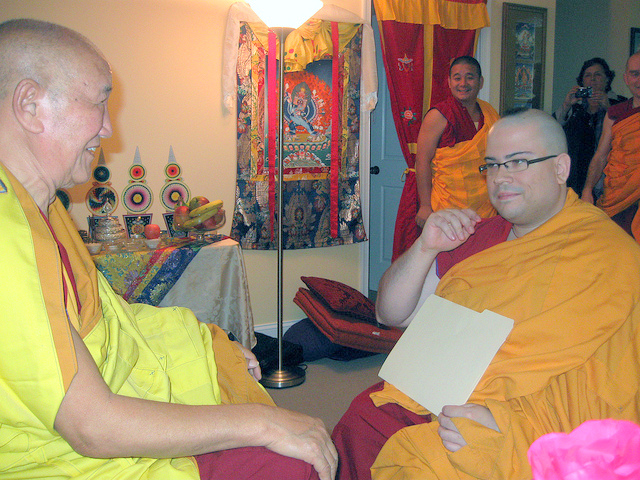
Ven. Losang Dondrub is ordained by Gyumed Khensur Rinpoche Lobsang Jampa, Guhyasamaja Center, Fairfax, Virginia, US, October 2013.
Mandala brings you news of Lama Zopa Rinpoche and of activities, teachings and events from over 160 FPMT centers, projects and services around the globe. If you like what you read on Mandala, consider becoming a Friend of FPMT, which supports our work.
13
Foundation for Developing Compassion and Wisdom Launches New Website
The Foundation for Developing Compassion and Wisdom (FDCW) is an FPMT-affiliated project “dedicated to promoting peace in the world through Universal Education for Compassion and Wisdom [UECW], a system of inner development that enables people of all ages, cultures and traditions to lead a happy and meaningful life and to be of service to others.” Inspired by FPMT founder Lama Yeshe, FDCW works to carry out his vision for “a new kind of education for the world.”
“The new website aims to present a clear and up-to-date overview of our aims and activities for everyone from seasoned UECW ‘elders’ to people who are encountering Universal Education for the very first time,” wrote FDCW director Alison Murdoch. FDCW programs include the 16 Guidelines for a Happy Life, Seven Steps to Knowledge Strength and Compassion, Transformative Mindfulness Methods for Inquiry and Intervention, Corporate-Based Mindfulness Training.
You can learn more about FDCW by visiting their website and signing up to their newsletter.
Mandala brings you news of Lama Zopa Rinpoche and of activities, teachings and events from over 160 FPMT centers, projects and services around the globe. If you like what you read on Mandala, consider becoming a Friend of FPMT, which supports our work.
- Home
- News/Media
- Study & Practice
- About FPMT Education Services
- Latest News
- Programs
- New to Buddhism?
- Buddhist Mind Science: Activating Your Potential
- Heart Advice for Death and Dying
- Discovering Buddhism
- Living in the Path
- Exploring Buddhism
- FPMT Basic Program
- FPMT Masters Program
- FPMT In-Depth Meditation Training
- Maitripa College
- Lotsawa Rinchen Zangpo Translator Program
- Universal Education for Compassion & Wisdom
- Online Learning Center
- Prayers & Practice Materials
- Overview of Prayers & Practices
- Full Catalogue of Prayers & Practice Materials
- Explore Popular Topics
- Benefiting Animals
- Chenrezig Resources
- Death & Dying Resources
- Lama Chopa (Guru Puja)
- Lama Zopa Rinpoche: Compendium of Precious Instructions
- Lama Zopa Rinpoche: Life Practice Advice
- Lama Zopa Rinpoche Practice Series
- Lamrim Resources
- Mantras
- Prayer Book Updates
- Purification Practices
- Sutras
- Thought Transformation (Lojong)
- Audio Materials
- Dharma Dates – Tibetan Calendar
- Translation Services
- Publishing Services
- Teachings and Advice
- Find Teachings and Advice
- Lama Zopa Rinpoche Advice Page
- Lama Zopa Rinpoche: Compendium of Precious Instructions
- Lama Zopa Rinpoche Video Teachings
- ༧སྐྱབས་རྗེ་བཟོད་པ་རིན་པོ་ཆེ་མཆོག་ནས་སྩལ་བའི་བཀའ་སློབ་བརྙན་འཕྲིན།
- Podcasts
- Lama Yeshe Wisdom Archive
- Buddhism FAQ
- Dharma for Young People
- Resources on Holy Objects
- Ways to Offer Support
- Centers
- Affiliates Area
- Teachers
- Projects
- Charitable Projects
- Make a Donation
- Applying for Grants
- News about Projects
- Other Projects within FPMT
- Support International Office
- Projects Photo Galleries
- Give Where Most Needed
- FPMT
- Shop
Subscribe to FPMT News
Translate*
*powered by Google TranslateTranslation of pages on fpmt.org is performed by Google Translate, a third party service which FPMT has no control over. The service provides automated computer translations that are only an approximation of the websites' original content. The translations should not be considered exact and only used as a rough guide.When others insult, rebuke and speak unpleasant words to us, although an intolerable pain arises like a thorn at the heart, if we comprehend the teachings then we can recognize the essenceless nature of these words which resemble an echo. So just as when an inanimate object is scolded, we will experience not the slightest mental turmoil.







